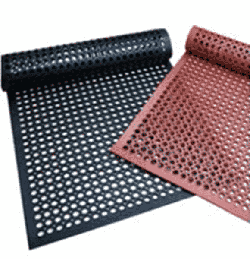Standing for long hours in the kitchen, whether at home or in a professional setting, can take a toll on your body. The discomfort, fatigue, and potential health issues that arise from prolonged standing are common problems many people face. However, there’s a simple solution that can significantly improve your comfort and productivity: anti-fatigue kitchen mats.
The Challenge of Standing for Long Periods in the Kitchen
Kitchens are bustling environments where standing for extended periods is often unavoidable. Whether you’re a home cook preparing meals for your family or a professional chef running a busy kitchen, the physical demands can be intense. Standing on hard surfaces like tile or concrete for hours can lead to discomfort in your feet, legs, and lower back. Over time, this can result in chronic pain, joint issues, and even conditions like plantar fasciitis or varicose veins. The impact of standing for long periods isn’t just physical. Fatigue can also affect your concentration and productivity, making it harder to stay focused on your tasks. In a fast-paced kitchen, where speed and precision are essential, this can lead to mistakes and accidents.What Makes Anti-Fatigue Kitchen Mats Effective?
Anti-fatigue mats are specifically designed to alleviate the discomfort associated with prolonged standing. They are made from materials that provide cushioning and support, such as high-density foam or gel, which helps to reduce the pressure on your feet and lower limbs. The science behind anti-fatigue mats is straightforward: by providing a softer surface to stand on, these mats encourage subtle movements in your leg muscles, which promotes better blood circulation. This helps to reduce the fatigue and discomfort that comes from standing still for long periods. Moreover, the cushioning effect of the mat reduces the impact on your joints, helping to prevent long-term injuries.Benefits of Anti-Fatigue Mats in the Kitchen
Investing in an anti-fatigue kitchen mat can bring numerous benefits, both immediate and long-term:- Increased Comfort: The primary benefit of anti-fatigue mats is the significant reduction in discomfort. By providing a softer surface to stand on, these mats help to alleviate the pain and fatigue that can result from standing on hard floors. This means you can work longer without feeling the strain on your body.
- Enhanced Safety: Kitchens can be hazardous environments, with spills and splashes increasing the risk of slips and falls. Many anti-fatigue mats are designed with non-slip surfaces, which help to reduce these risks. Additionally, the mats provide a stable, cushioned surface that can help prevent accidents caused by sudden movements or fatigue-related slips.
- Improved Productivity: When you’re comfortable, you’re more focused and efficient. Anti-fatigue mats can help you stay on your feet longer without discomfort, allowing you to maintain your concentration and productivity throughout your work in the kitchen. This is particularly important in professional settings where long shifts are common.
Types of Anti-Fatigue Mats for Kitchens
There are various types of anti-fatigue mats available, each suited to different needs and environments:- Gel Mats: Gel-filled mats offer superior cushioning and are ideal for kitchens where you spend long hours standing. The gel conforms to the shape of your feet, providing excellent support and comfort.
- Foam Mats: Foam mats are lightweight and easy to clean, making them a great option for home kitchens. They offer good cushioning and are available in various thicknesses to suit your comfort needs.
- Rubber Mats: Rubber mats are highly durable and resistant to spills, making them perfect for commercial kitchens. They provide a firm yet cushioned surface and are easy to clean, making them a practical choice for busy environments.
- Textured Mats: These mats often feature a textured surface that enhances grip and reduces the risk of slips. They are ideal for kitchens where spills are frequent, providing both comfort and safety.
Choosing the Right Anti-Fatigue Mat for Your Kitchen
Selecting the right anti-fatigue mat involves considering several factors:- Size: The mat should be large enough to cover the area where you spend the most time standing. In a home kitchen, this might be in front of the stove or sink. In a commercial kitchen, consider placing mats in front of prep stations or other high-use areas.
- Material: Consider the environment where the mat will be used. For home kitchens, a foam or gel mat might provide the comfort you need. In commercial settings, a durable rubber mat might be more suitable due to its resistance to spills and heavy use.
- Ease of Cleaning: Kitchens can be messy, so choose a mat that’s easy to clean. Rubber and some foam mats can be wiped down quickly, while gel mats might require more careful cleaning.
- Thickness: The thickness of the mat will affect its cushioning. Thicker mats generally offer more support, but they can also be harder to move around. Choose a thickness that balances comfort with practicality.

